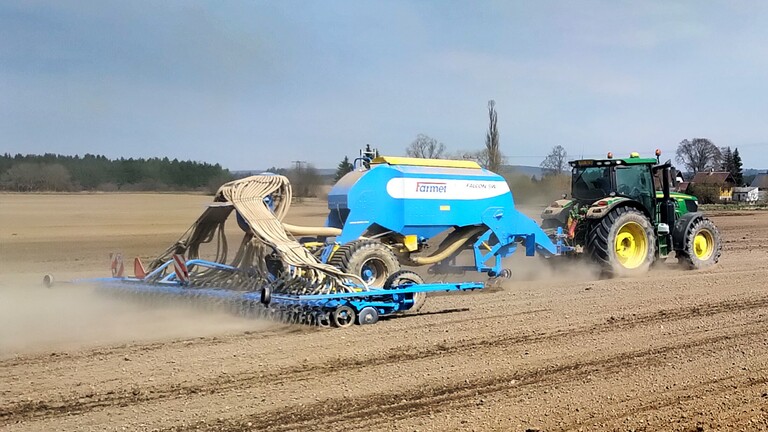During the spring sewing season, I visited the Staré Sedlo Farm, located in the foothills of Český les, near Přimda, the oldest ruins in Bohemia. I spent one afternoon with Jiří Černý, the owner and founder of the farm, who answered my questions and showed me what life at his farm is like.
How far back does the history of your farm go?
The history of the family farm at No. 40 in Staré Sedlo goes back several centuries. The modern history of the current owner’s family was affected by an event of 1955 when the owner’s grandfather was forced to give up farming under the influence of communist collectivisation. At that time, the farm owner was declared to be a kulak and exploiter of his neighbours and he was banned from the farmstead and had to move to the nearby town of Bor u Tachova.
 What was the beginning like and what technology did you use then?
What was the beginning like and what technology did you use then?
We founded the farm in 2007 and started working on 12 hectares. We purchased a Supra machine and the farm continued to expand and grow. At present, we farm on an area of 1,350 hectares and we no longer have Supra.
Correct me if I am wrong but I believe that you are a fully ecological farm?
Yes, we decided not to use any chemical substances in the plant production at the very beginning. This idea became the pillar of our farm and it is still the main ideal. We believe that it is the only way of making soil permanently sustainable for future generations.
Please, describe the conditions at your farm.
We farm at an altitude of 450–500 metres, the soil is rather heavier and rocky. In 2018, the precipitation total was 350 mm. It was not a lot, but it was sufficient. The rain came at a good time, which was reflected in the quality of the crop.
What crops do you grow and what is your yield?
The basic crops we grow are spelt and oats, followed with spring and winter wheat, caraway, organic oilseed rape, peas and milk thistle. We have to observe a precise seeding procedure and alternate the crops on several fields due to ecological reasons. The spelt and wheat yield 3 to 4 tonnes, the oats 4 tonnes. It is a decent yield with regard to our conditions, soil and the elevation, but we would like to go further and intensify our production.
You started with a width of 3 metres with Farmet and now you are at 9?
The three-metre-wide cultivator was our first Farmet machine. As the farm expanded, the working width of our machines also increased. We currently use Kompaktomat with a width of 6 metres, but we will need to replace it with a wider machine in the future. The arable soil that we cultivate with conventional technology lies on an area of 1,061 hectares and this spring, we use Kompaktomat to cultivate over 400 hectares. Another Farmet machine in our fleet is the Falcon SW seed drill with a 9metre seeding bar. I guess I can disclose that we have ordered another machine from your production.
What did you consider important in purchasing a new seed drill?
Above all, it was capacity and efficiency. We needed the largest hopper and the largest working width possible. In ecological farming, you cannot do without catch crop. We perform stubble cultivation right after harvest when we sew catch crop using the Farmet seed drill. One person can easily manage to crop 100 hectares per day, which is the greatest benefit of the seed drill. Yesterday, we cropped 70 hectares in four passes and with changing the crop from oats to wheat. However, we usually sew 50 hectares per day because we are limited with seedbed cultivation.
Spelt is one of the crops you grow. How does Falcon SW cope with this crop?
Sewing spelt comes with some typical difficulties and lays high demands on the seed drill. We have not had any problems with establishing the crop thanks to Falcon SW that has an optimised air system and quality seed dispensers. Falcon SW even manages the required seeding amount of 250 kg/ha, which were not able to achieve with the previous competitive seed drill. Two years ago, we built the warehouse and launched a new post-harvest line. All our production is sold abroad, mostly to Switzerland.
And what are your plans for the future?
The Germans are better in ecological farming and we would like to measure up to them. We are thinking about purchasing a sprayer. There are a lot of elements and microelements on the market that are permitted in ecology and can be applied. If Farmet manufactured sprayers, our choice would be clear. Our neighbours sometimes think that the Farmet seed drill is a sprayer, probably thanks to its unique design, the large hopper and large width.
I would like to thank the Černý family for the time they spent with me in the spring season and for their knowledge of ecological farming that they shared with me. I hope that they will continue being loyal to the Farmet brand and that it will help them succeed in the competition with German ecological farming.
Ing. Václav Mytyska
Product and Technology Advisor
